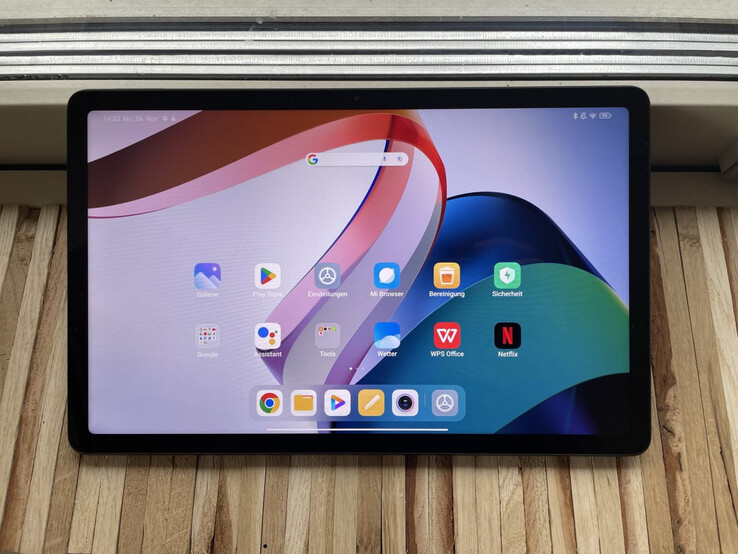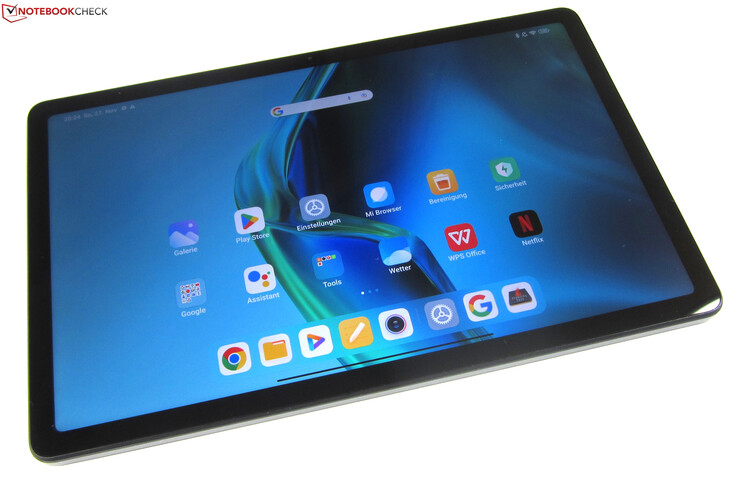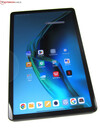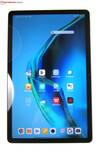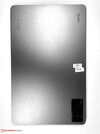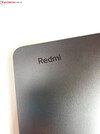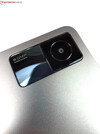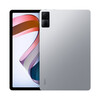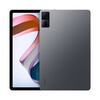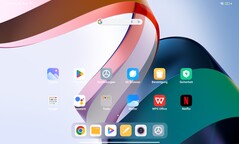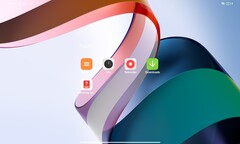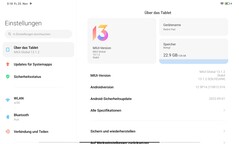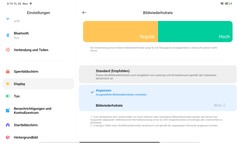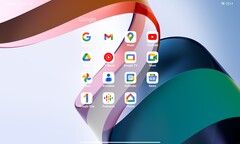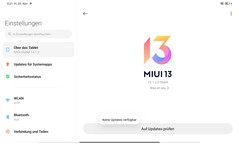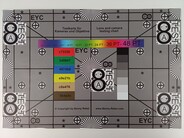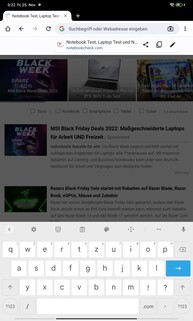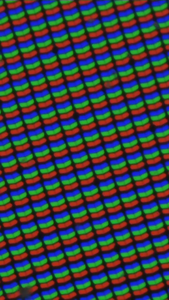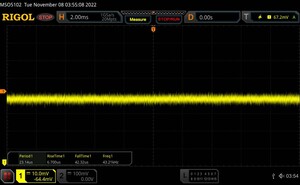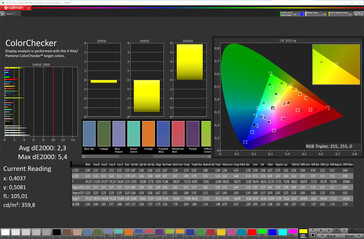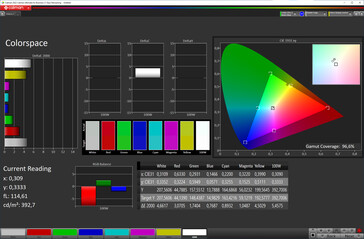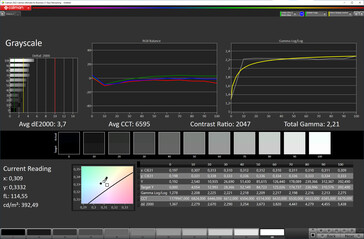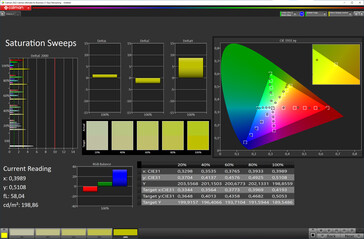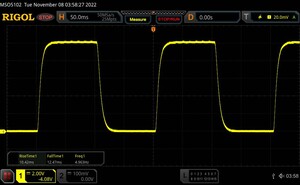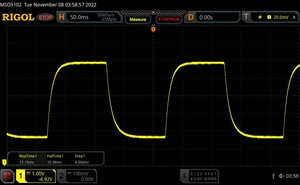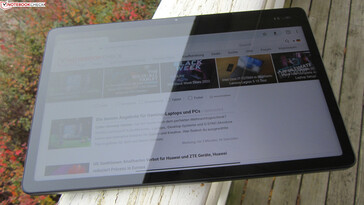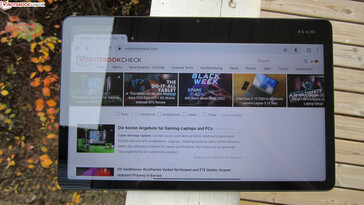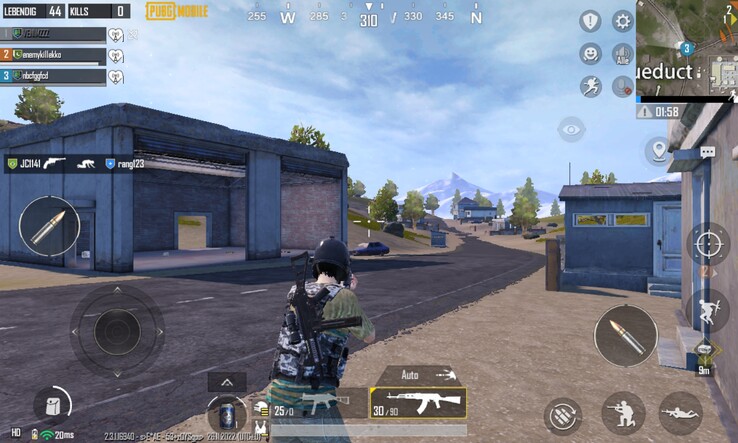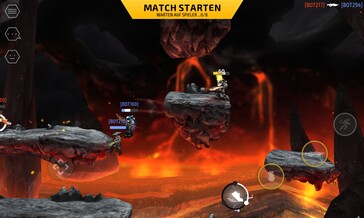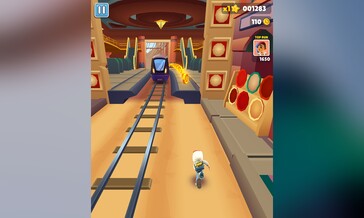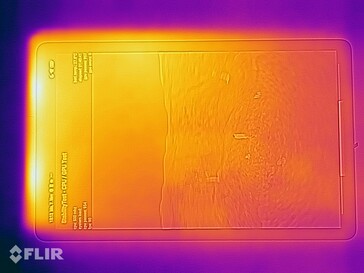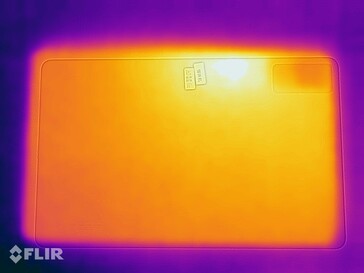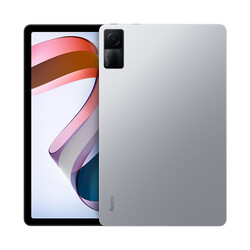Xiaomi Redmi Pad review - Affordable Android tablet with 90 Hz and 4 speakers
Different device class, same goal: Like the popular Redmi smartphone series, which consists of budget and mid-range phones that tend to offer a lot for their price, the Redmi Pad, too, tries to give you the most bang for your buck.
The Xiaomi Redmi Pad starts at around 240 USD. The 10.6-inch Android 12 tablet comes with the octa-core MediaTek Helio G99 SoC and up to 128 GB storage. The included charger is able to charge the internal 8000-mAh battery at up to 18 watts. Although the Redmi Pad does well in many areas, we also discovered some drawbacks during our review.
Potential Competitors in Comparison
Rating | Date | Model | Weight | Height | Size | Resolution | Price |
|---|---|---|---|---|---|---|---|
| 84.6 % v7 (old) | 12 / 2022 | Xiaomi Redmi Pad Helio G99, Mali-G57 MP2 | 445 g | 7.05 mm | 10.61" | 2000x1200 | |
| 88.5 % v7 (old) | 10 / 2021 | Apple iPad 2021 A13 Bionic, A13 Bionic GPU | 487 g | 7.5 mm | 10.20" | 2160x1620 | |
| 80.9 % v7 (old) | 04 / 2022 | Huawei MatePad T10S Kirin 710A, Mali-G51 MP4 | 450 g | 7.85 mm | 10.10" | 1920x1200 | |
| 81 % v7 (old) | 02 / 2022 | Samsung Galaxy Tab A8 2022 T618, Mali-G52 MP2 | 508 g | 6.9 mm | 10.50" | 1920x1200 | |
| 80.5 % v7 (old) | 03 / 2022 | Teclast T40 Pro T618, Mali-G52 MP2 | 480 g | 9.2 mm | 10.36" | 2000x1200 | |
| 87.6 % v7 (old) | 12 / 2021 | Xiaomi Pad 5 SD 860, Adreno 640 | 511 g | 6.85 mm | 11.00" | 2560x1600 |
Case - Lightweight Aluminum Unibody Chassis
Although the Redmi Series consists of more budget-oriented smartphones and tablets, this does not necessarily mean that users will have to make major compromises when it comes to the materials or the build quality. In the same vein, the Redmi Pad does not fit the stereotypical cheap device archetype.
The flat metal case has a height of 7.05 mm and leaves a premium visual and haptic impression in addition to appearing fairly sturdy. Although the case can be twisted slightly from the shorter edges, the rigidity is more than sufficient for day-to-day use. However, the tablet does not have an IP certification.
With a weight of 445 grams, the Redmi Pad is fairly lightweight and lighter than all competitors with similar dimensions from our comparison including the Apple iPad 2021 and the Samsung Galaxy Tab A8 2022.
Xiaomi offers three color variants. Users can choose between gray (Graphite Gray), silver (Moonlight Silver), and a light green (Mint Green).
Connectivity - 3 Memory Configurations
The Xiaomi Redmi Pad is available in three different configurations. At the time of writing, the tablet costs around 240 USD with 3 GB LPDDR4X RAM and 64 GB UFS-2.2 storage. The 4/128GB and 6/128GB models are available for about 250 USD and 280 USD, respectively. The internal storage can be expanded via a microSD card formatted in exFAT with a capacity of up to 1 TB.
An additional 8/128-GB configuration is currently exclusively available on the Chinese market. Whether it will find its way to other regions is uncertain at this time.
The Redmi Pad uses a USB-C 2.0 interface for charging purposes and data transfers. Due to the lack of a 3.5mm headphone jack, the USB-OTG-capable port also serves as an audio output. The Redmi Pad produces Dolby Atmos surround sound with its quad speakers, which occupy the shorter edges of the device in pairs.
microSD Card Reader
The microSD card reader of the Redmi Tab only reaches average speeds in conjunction with our reference Angelbird AV Pro V60 memory card.
Although sequential read and write rates of 66.1 MB/s and 35.8 MB/s, respectively, are a decent, there are recurring dips in performance particularly during read operations. Furthermore, the Xiaomi tablet is very slow in our copy test at 9.48 MB/s.
| SD Card Reader - average JPG Copy Test (av. of 3 runs) | |
| Samsung Galaxy Tab A8 2022 (Angelbird AV Pro V60) | |
| Teclast T40 Pro (Angelbird AV Pro V60) | |
| Huawei MatePad T10S (Angelbird V60) | |
| Xiaomi Redmi Pad (Angelbird AV Pro V60) | |
Cross Platform Disk Test (CPDT)
Software - Android 12 and MIUI 13 for the Xiaomi Redmi Pad
The Redmi Pad runs Android 12 with Xiaomi's own MIUI user interface version 13.1. The manufacturer does not include a lot in terms of extra software. Aside from the Google applications and a small collection of Xiaomi tools, only the two third-party apps WPS Office and Netflix - both of which can be removed - come preinstalled. Thanks to DRM Widevine L1 support, the tablet can be used to stream HD-quality content.
MIUI 13 not only allows for apps to be run in fullscreen mode, but also in a windowed view that allows multiple apps to be open simultaneously. Additionally, two app windows can be automatically aligned to take up half the screen, each. Using this feature requires the 4-GB version of the tablet (or higher), however, since the 3-GB model does not support split view.
At the time of testing (early December), the Android security patches of the Redmi Tab date back to 01.09.22, making them fairly outdated. According to Xiaomi, there is no official support window for OS updates and security patches.
Communication and GNSS - Bluetooth 5.3 and WiFi 5
With Bluetooth 5.3 and Wi-Fi 5, the Xiaomi Redmi Pad only supports two communication channels, since neither NFC nor WWAN options are on board. There is also no GPS module.
In conjunction with our Asus ROG Rapture GT-AXE11000 reference router, the Xiaomi reaches very consistent Wi-Fi transfer speeds, which come close to the limits of Wi-Fi 5 with up to 369 Mb/s. The low initial transmission speed is caused by the router "waking up".
| Networking | |
| iperf3 transmit AX12 | |
| Xiaomi Pad 5 | |
| Apple iPad 2021 | |
| iperf3 receive AX12 | |
| Xiaomi Pad 5 | |
| Apple iPad 2021 | |
| iperf3 receive AXE11000 | |
| Xiaomi Redmi Pad | |
| Samsung Galaxy Tab A8 2022 | |
| Teclast T40 Pro | |
| Huawei MatePad T10S | |
| iperf3 transmit AXE11000 | |
| Xiaomi Redmi Pad | |
| Samsung Galaxy Tab A8 2022 | |
| Teclast T40 Pro | |
| Huawei MatePad T10S | |
Cameras - Special Features for Group Video Chats
The Xiaomi Redmi Pad has an 8-MP selfie camera on the longest edge of the tablet. It covers a 105° field of view, captures videos at up to 1080p with 30 frames per second, and comes with the FocusFrame feature, which is supposed to enhance group video calls.
FocusFrame works similarly to Apple's Center Stage. During video calls, the selfie camera of the Redmi Tab automatically detects all current participants and keeps them in focus, even when they move. However, only a few apps are currently supported. According to Xiaomi, FocusFrame is available for Facebook Messenger, WeChat, and WhatsApp.
The main camera has a resolution of 8 MP and also supports video recording at up to 1080p with 30 FPS. Like the selfie camera, it shines with a good video quality under good lighting conditions, which takes a big hit in low-light situations due to significant image noise. The same holds true for pictures.
The main camera takes decent pictures with natural colors and good contrast under good ambient lighting. Since the images are lacking in terms of details, zooming in is inadvisable. Like the selfie camera, the main camera also is out of its depth in low-light situations.
Image comparison
Choose a scene and navigate within the first image. One click changes the position on touchscreens. One click on the zoomed-in image opens the original in a new window. The first image shows the scaled photograph of the test device.
Tageslicht-Aufnahme 1Tageslicht-Aufnahme 25-facher ZoomLowlight-AufnahmeThe main camera shows itself to be very accurate under ideal conditions in our test lab (maximum deltaE of 8.64). Under poor lighting conditions, which we emulate with a 1-Lux scene, this no longer holds true. The color accuracy then deviates widely from its ideal range and the test chart, which was previously clearly visible, almost entirely disappears in the darkness.
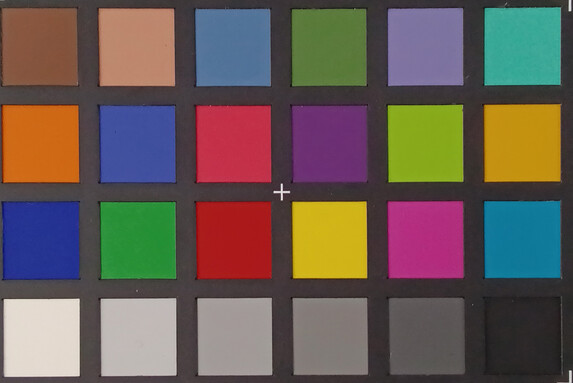

Accessories and Warranty - 22.5-Watt Charger Included
Xiaomi includes a 22.5-watt charger, a USB cable (type-A-to-type-C), a tool to eject microSD cards from the slot, a quick-start guide, and a warranty card with the Redmi Tab. The manufacturer offers no accessories specifically made for the tablet.
Since there is no official warranty information for the Xiaomi Redmi Tab in the US, buyers should be aware of the individual retailer conditions and our Warranty FAQ.
Input Devices & Handling - 90-Hz und 2D Facial Recognition
Thanks to the 90-Hz display and the 8-core MediaTek Helio G99 SoC, the Xiaomi Redmi Pad feels very responsive and smooth during use. Even more demanding apps usually run without any issues and the performance is sufficient for opening multiple apps simultaneously. It should be noted that this applies to our test model with 4 GB of RAM. By contrast, there may be occasional stuttering with the 3-GB version.
Since there is no fingerprint sensor, 2D facial recognition is the only available biometric authentification option. While Face Unlock works without any hickups and unlocks the Redmi Tab without any noticeable delay, it is less secure than PIN or pattern unlock due to its software-based nature. The tablet can also be unlocked with a Bluetooth device, but this only works with certain Xiaomi smartwatches and smartbands.
Display - IPS Screen with 400 Nits
The Redmi Pad's 10.6-inch screen has a native resolution of 2000 x 1200 pixels with a 15:9 aspect ratio for a pixel density of 220 PPI. The IPS panel has a nominal brightness of 400 nits and does not use pulse-width modulation, making the tablet potentially a good choice for sensitive users. As our slow-motion observations with a microscope show, Temporal Dithering is absent as well.
When displaying a purely white image (APL50), the display reaches an average brightness of 401.6 nits. This value increases to 414 nits when repeating this test with a smaller image (APL18). The highest luminance of 418 nits can be reached with the ambient light sensor disabled. We measure 1.54 nits on the lowest brightness setting.
| |||||||||||||||||||||||||
Brightness Distribution: 90 %
Center on Battery: 418 cd/m²
Contrast: 1493:1 (Black: 0.28 cd/m²)
ΔE ColorChecker Calman: 2.3 | ∀{0.5-29.43 Ø4.78}
ΔE Greyscale Calman: 3.7 | ∀{0.09-98 Ø5}
96.6% sRGB (Calman 2D)
Gamma: 2.21
CCT: 6595 K
| Xiaomi Redmi Pad IPS, 2000x1200, 10.6" | Apple iPad 2021 IPS, 2160x1620, 10.2" | Huawei MatePad T10S LCD IPS, 1920x1200, 10.1" | Samsung Galaxy Tab A8 2022 TFT-LCD, 1920x1200, 10.5" | Teclast T40 Pro IPS, 2000x1200, 10.4" | Xiaomi Pad 5 IPS, 2560x1600, 11" | |
|---|---|---|---|---|---|---|
| Screen | 3% | -29% | -78% | -24% | -22% | |
| Brightness middle (cd/m²) | 418 | 507 21% | 285 -32% | 368 -12% | 433 4% | 491 17% |
| Brightness (cd/m²) | 402 | 491 22% | 282 -30% | 346 -14% | 412 2% | 473 18% |
| Brightness Distribution (%) | 90 | 90 0% | 91 1% | 91 1% | 86 -4% | 91 1% |
| Black Level * (cd/m²) | 0.28 | 0.5 -79% | 0.3 -7% | 0.61 -118% | 0.48 -71% | 0.87 -211% |
| Contrast (:1) | 1493 | 1014 -32% | 950 -36% | 603 -60% | 902 -40% | 564 -62% |
| Colorchecker dE 2000 * | 2.3 | 1.7 26% | 3.53 -53% | 6.9 -200% | 3 -30% | 1.9 17% |
| Colorchecker dE 2000 max. * | 5.4 | 3.9 28% | 5.84 -8% | 11.4 -111% | 7.2 -33% | 4.1 24% |
| Greyscale dE 2000 * | 3.7 | 2.4 35% | 6.2 -68% | 7.7 -108% | 4.4 -19% | 3 19% |
| Gamma | 2.21 100% | 2.25 98% | 2.044 108% | 2.16 102% | 2.12 104% | 2.21 100% |
| CCT | 6595 99% | 6923 94% | 8130 80% | 8547 76% | 7003 93% | 7182 91% |
* ... smaller is better
Screen Flickering / PWM (Pulse-Width Modulation)
| Screen flickering / PWM not detected | |||
In comparison: 53 % of all tested devices do not use PWM to dim the display. If PWM was detected, an average of 8101 (minimum: 5 - maximum: 343500) Hz was measured. | |||
The colors of the IPS display can be adjusted by choosing between the three color presets Vivid, Saturated, and Standard. Additionally, the color temperature can be altered with a color wheel or one of three presets (Standard, Warm, or Cool).
The Standard color and color temperature settings provide the most accurate results. With these settings, the screen achieves a good contrast ratio, black value, and color temperature. For daily use, the color accuracy is more than sufficient as well.
Display Response Times
| ↔ Response Time Black to White | ||
|---|---|---|
| 22.89 ms ... rise ↗ and fall ↘ combined | ↗ 10.42 ms rise | |
| ↘ 12.47 ms fall | ||
| The screen shows good response rates in our tests, but may be too slow for competitive gamers. In comparison, all tested devices range from 0.1 (minimum) to 240 (maximum) ms. » 50 % of all devices are better. This means that the measured response time is worse than the average of all tested devices (20.2 ms). | ||
| ↔ Response Time 50% Grey to 80% Grey | ||
| 38.13 ms ... rise ↗ and fall ↘ combined | ↗ 17.15 ms rise | |
| ↘ 20.98 ms fall | ||
| The screen shows slow response rates in our tests and will be unsatisfactory for gamers. In comparison, all tested devices range from 0.165 (minimum) to 636 (maximum) ms. » 56 % of all devices are better. This means that the measured response time is worse than the average of all tested devices (31.6 ms). | ||
With its good viewing angles, the Xiaomi Redmi Pad's IPS panel performs well during outdoor use, provided the ambient light conditions are not too bright. Due to the somewhat low maximum brightness, the readability of the display quickly deteriorates under direct sunlight, making a move to the shade almost a necessity.
Performance - Redmi Pad with MediaTek Helio G99
With the MediaTek Helio G99 introduced in August 2022, the Xiaomi Redmi Pad is based on an upper mid-range ARM SoC. The 6-nm octa-core processor relies on two ARM Cortex-A76 cores with a clock speed of up to 2.2 GHz for demanding tasks and a cluster consisting of six energy-efficient Cortex-A55 cores with up to 2-GHz clock speeds. The GPU is an ARM Mali-G57 MP2.
In our synthetic benchmarks, the Redmi Pad positions itself ahead of many similarly priced tablets. In terms of performance, our test device falls between the eclast T40 Pro (UNISOC T618) and its in-house competitor Xiaomi Pad 5, which offers significantly faster performance thanks to its Snapdragon 860 SoC. The Apple iPad 2021 comes with even better performance, beating all its Android alternatives.
| AImark - Score v2.x | |
| Xiaomi Pad 5 | |
| Teclast T40 Pro | |
| Samsung Galaxy Tab A8 2022 | |
| Xiaomi Redmi Pad | |
| Average Mediatek Helio G99 (n=1) | |
| Huawei MatePad T10S | |
| Apple iPad 2021 | |
| UL Procyon AI Inference for Android - Overall Score NNAPI | |
| Average of class Tablet (2597 - 76852, n=62, last 2 years) | |
| Xiaomi Redmi Pad | |
| Average Mediatek Helio G99 (6323 - 9695, n=13) | |
| VRMark - Amber Room | |
| Xiaomi Redmi Pad | |
| Average Mediatek Helio G99 (n=1) | |
| Average of class Tablet (n=1last 2 years) | |
Similarly, the Xiaomi Redmi Pad delivers an average performance compared to its competitors in the graphics benchmarks. Both the Xiaomi Pad 5 and Apple iPad 2021 still manage to outperform it by significant margins.
GFXBench (DX / GLBenchmark) 2.7: T-Rex Onscreen | 1920x1080 T-Rex Offscreen
GFXBench 3.0: on screen Manhattan Onscreen OGL | 1920x1080 1080p Manhattan Offscreen
GFXBench 3.1: on screen Manhattan ES 3.1 Onscreen | 1920x1080 Manhattan ES 3.1 Offscreen
GFXBench: on screen Car Chase Onscreen | 1920x1080 Car Chase Offscreen | on screen Aztec Ruins High Tier Onscreen | 2560x1440 Aztec Ruins High Tier Offscreen | on screen Aztec Ruins Normal Tier Onscreen | 1920x1080 Aztec Ruins Normal Tier Offscreen
Basemark ES 3.1 / Metal: offscreen Overall Score
Basemark GPU 1.2: Vulkan Medium Native | 1920x1080 Vulkan Medium Offscreen | OpenGL Medium Native | 1920x1080 OpenGL Medium Offscreen
| 3DMark / Wild Life Extreme Unlimited | |
| Apple iPad 2021 | |
| Xiaomi Pad 5 | |
| Xiaomi Redmi Pad | |
| Teclast T40 Pro | |
| Samsung Galaxy Tab A8 2022 | |
| Huawei MatePad T10S | |
| 3DMark / Wild Life Extreme | |
| Apple iPad 2021 | |
| Xiaomi Pad 5 | |
| Xiaomi Redmi Pad | |
| Samsung Galaxy Tab A8 2022 | |
| Teclast T40 Pro | |
| Huawei MatePad T10S | |
| 3DMark / Wild Life Unlimited Score | |
| Apple iPad 2021 | |
| Xiaomi Pad 5 | |
| Xiaomi Redmi Pad | |
| Teclast T40 Pro | |
| Samsung Galaxy Tab A8 2022 | |
| Huawei MatePad T10S | |
| 3DMark / Wild Life Score | |
| Apple iPad 2021 | |
| Xiaomi Pad 5 | |
| Xiaomi Redmi Pad | |
| Samsung Galaxy Tab A8 2022 | |
| Teclast T40 Pro | |
| Huawei MatePad T10S | |
| 3DMark / Sling Shot OpenGL ES 3.0 Unlimited | |
| Xiaomi Pad 5 | |
| Xiaomi Redmi Pad | |
| Teclast T40 Pro | |
| Samsung Galaxy Tab A8 2022 | |
| Huawei MatePad T10S | |
| Apple iPad 2021 | |
| 3DMark / Sling Shot OpenGL ES 3.0 Unlimited Graphics | |
| Xiaomi Pad 5 | |
| Xiaomi Redmi Pad | |
| Teclast T40 Pro | |
| Samsung Galaxy Tab A8 2022 | |
| Huawei MatePad T10S | |
| Apple iPad 2021 | |
| 3DMark / Sling Shot OpenGL ES 3.0 Unlimited Physics | |
| Xiaomi Pad 5 | |
| Xiaomi Redmi Pad | |
| Teclast T40 Pro | |
| Samsung Galaxy Tab A8 2022 | |
| Huawei MatePad T10S | |
| Apple iPad 2021 | |
| 3DMark / Sling Shot Extreme (ES 3.1) Unlimited | |
| Xiaomi Pad 5 | |
| Apple iPad 2021 | |
| Xiaomi Redmi Pad | |
| Teclast T40 Pro | |
| Samsung Galaxy Tab A8 2022 | |
| Huawei MatePad T10S | |
| 3DMark / Sling Shot Extreme (ES 3.1) Unlimited Graphics | |
| Apple iPad 2021 | |
| Xiaomi Pad 5 | |
| Xiaomi Redmi Pad | |
| Teclast T40 Pro | |
| Samsung Galaxy Tab A8 2022 | |
| Huawei MatePad T10S | |
| 3DMark / Sling Shot Extreme (ES 3.1) Unlimited Physics | |
| Xiaomi Pad 5 | |
| Xiaomi Redmi Pad | |
| Teclast T40 Pro | |
| Samsung Galaxy Tab A8 2022 | |
| Huawei MatePad T10S | |
| Apple iPad 2021 | |
| 3DMark / Sling Shot Extreme (Vulkan) Unlimited | |
| Xiaomi Pad 5 | |
| Xiaomi Redmi Pad | |
| Teclast T40 Pro | |
| Samsung Galaxy Tab A8 2022 | |
| Huawei MatePad T10S | |
| 3DMark / Sling Shot Extreme (Vulkan) Unlimited Graphics | |
| Xiaomi Pad 5 | |
| Xiaomi Redmi Pad | |
| Teclast T40 Pro | |
| Samsung Galaxy Tab A8 2022 | |
| Huawei MatePad T10S | |
| 3DMark / Sling Shot Extreme (Vulkan) Unlimited Physics | |
| Xiaomi Redmi Pad | |
| Xiaomi Pad 5 | |
| Teclast T40 Pro | |
| Samsung Galaxy Tab A8 2022 | |
| Huawei MatePad T10S | |
| 3DMark / Sling Shot Extreme (ES 3.1) | |
| Xiaomi Redmi Pad | |
| Teclast T40 Pro | |
| Samsung Galaxy Tab A8 2022 | |
| Huawei MatePad T10S | |
| Xiaomi Pad 5 | |
| 3DMark / Sling Shot Extreme (ES 3.1) Graphics | |
| Xiaomi Redmi Pad | |
| Teclast T40 Pro | |
| Samsung Galaxy Tab A8 2022 | |
| Huawei MatePad T10S | |
| Xiaomi Pad 5 | |
| 3DMark / Sling Shot Extreme (ES 3.1) Physics | |
| Xiaomi Redmi Pad | |
| Teclast T40 Pro | |
| Samsung Galaxy Tab A8 2022 | |
| Huawei MatePad T10S | |
| Xiaomi Pad 5 | |
| 3DMark / Sling Shot OpenGL ES 3.0 | |
| Xiaomi Redmi Pad | |
| Teclast T40 Pro | |
| Samsung Galaxy Tab A8 2022 | |
| Huawei MatePad T10S | |
| Xiaomi Pad 5 | |
| 3DMark / Sling Shot OpenGL ES 3.0 Graphics | |
| Xiaomi Redmi Pad | |
| Teclast T40 Pro | |
| Samsung Galaxy Tab A8 2022 | |
| Huawei MatePad T10S | |
| Xiaomi Pad 5 | |
| 3DMark / Sling Shot OpenGL ES 3.0 Physics | |
| Xiaomi Redmi Pad | |
| Teclast T40 Pro | |
| Samsung Galaxy Tab A8 2022 | |
| Huawei MatePad T10S | |
| Xiaomi Pad 5 | |
| GFXBench (DX / GLBenchmark) 2.7 / T-Rex Onscreen | |
| Xiaomi Pad 5 | |
| Apple iPad 2021 | |
| Xiaomi Redmi Pad | |
| Samsung Galaxy Tab A8 2022 | |
| Teclast T40 Pro | |
| Huawei MatePad T10S | |
| GFXBench (DX / GLBenchmark) 2.7 / T-Rex Offscreen | |
| Apple iPad 2021 | |
| Xiaomi Pad 5 | |
| Xiaomi Redmi Pad | |
| Huawei MatePad T10S | |
| Samsung Galaxy Tab A8 2022 | |
| Teclast T40 Pro | |
| GFXBench 3.0 / Manhattan Onscreen OGL | |
| Xiaomi Pad 5 | |
| Apple iPad 2021 | |
| Xiaomi Redmi Pad | |
| Samsung Galaxy Tab A8 2022 | |
| Teclast T40 Pro | |
| Huawei MatePad T10S | |
| GFXBench 3.0 / 1080p Manhattan Offscreen | |
| Apple iPad 2021 | |
| Xiaomi Pad 5 | |
| Xiaomi Redmi Pad | |
| Huawei MatePad T10S | |
| Samsung Galaxy Tab A8 2022 | |
| Teclast T40 Pro | |
| GFXBench 3.1 / Manhattan ES 3.1 Onscreen | |
| Apple iPad 2021 | |
| Xiaomi Pad 5 | |
| Xiaomi Redmi Pad | |
| Samsung Galaxy Tab A8 2022 | |
| Teclast T40 Pro | |
| Huawei MatePad T10S | |
| GFXBench 3.1 / Manhattan ES 3.1 Offscreen | |
| Apple iPad 2021 | |
| Xiaomi Pad 5 | |
| Xiaomi Redmi Pad | |
| Huawei MatePad T10S | |
| Samsung Galaxy Tab A8 2022 | |
| Teclast T40 Pro | |
| GFXBench / Car Chase Onscreen | |
| Apple iPad 2021 | |
| Xiaomi Pad 5 | |
| Xiaomi Redmi Pad | |
| Samsung Galaxy Tab A8 2022 | |
| Huawei MatePad T10S | |
| Teclast T40 Pro | |
| GFXBench / Car Chase Offscreen | |
| Apple iPad 2021 | |
| Xiaomi Pad 5 | |
| Xiaomi Redmi Pad | |
| Samsung Galaxy Tab A8 2022 | |
| Huawei MatePad T10S | |
| Teclast T40 Pro | |
| GFXBench / Aztec Ruins High Tier Onscreen | |
| Apple iPad 2021 | |
| Xiaomi Pad 5 | |
| Xiaomi Redmi Pad | |
| Samsung Galaxy Tab A8 2022 | |
| Teclast T40 Pro | |
| Huawei MatePad T10S | |
| GFXBench / Aztec Ruins High Tier Offscreen | |
| Apple iPad 2021 | |
| Xiaomi Pad 5 | |
| Xiaomi Redmi Pad | |
| Samsung Galaxy Tab A8 2022 | |
| Teclast T40 Pro | |
| Huawei MatePad T10S | |
| GFXBench / Aztec Ruins Normal Tier Onscreen | |
| Apple iPad 2021 | |
| Xiaomi Pad 5 | |
| Xiaomi Redmi Pad | |
| Samsung Galaxy Tab A8 2022 | |
| Teclast T40 Pro | |
| Huawei MatePad T10S | |
| GFXBench / Aztec Ruins Normal Tier Offscreen | |
| Apple iPad 2021 | |
| Xiaomi Pad 5 | |
| Xiaomi Redmi Pad | |
| Samsung Galaxy Tab A8 2022 | |
| Teclast T40 Pro | |
| Huawei MatePad T10S | |
| Basemark ES 3.1 / Metal / Overall Score | |
| Apple iPad 2021 | |
| Xiaomi Redmi Pad | |
| Basemark GPU 1.2 / Vulkan Medium Native | |
| Xiaomi Redmi Pad | |
| Basemark GPU 1.2 / Vulkan Medium Offscreen | |
| Xiaomi Redmi Pad | |
| Basemark GPU 1.2 / OpenGL Medium Native | |
| Xiaomi Redmi Pad | |
| Basemark GPU 1.2 / OpenGL Medium Offscreen | |
| Xiaomi Redmi Pad | |
The Xiaomi Redmi Pad is an excellent choice for web browsing and able to load even complex sites quickly. Regardless, it places lower than the Xiaomi Pad 5 in our browser benchmarks.
| Jetstream 2 - 2.0 Total Score | |
| Average of class Tablet (22.3 - 395, n=68, last 2 years) | |
| Apple iPad 2021 (Safari 15) | |
| Average Mediatek Helio G99 (46.9 - 92.8, n=15) | |
| Xiaomi Pad 5 (Chrome 96.0.4664.45) | |
| Xiaomi Redmi Pad (Chrome 107.0.5304.105) | |
| Samsung Galaxy Tab A8 2022 (Chrome 94.0.4606.85) | |
| Huawei MatePad T10S (Huawei V12) | |
| JetStream 1.1 - Total Score | |
| Apple iPad 2021 (Safari 15) | |
| Xiaomi Pad 5 (Chrome 96.0.4664.45) | |
| Average Mediatek Helio G99 (n=1) | |
| Xiaomi Redmi Pad (Chrome 107.0.5304.105) | |
| Teclast T40 Pro (Chrome 98) | |
| Samsung Galaxy Tab A8 2022 (Chrome 94.0.4606.85) | |
| Huawei MatePad T10S (Huawei V12) | |
| WebXPRT 4 - Overall | |
| Average of class Tablet (26 - 376, n=71, last 2 years) | |
| Average Mediatek Helio G99 (39 - 89, n=13) | |
| Xiaomi Redmi Pad (Chrome 107.0.5304.105) | |
| WebXPRT 3 - Overall | |
| Average of class Tablet (39 - 480, n=25, last 2 years) | |
| Apple iPad 2021 (Safari 15) | |
| Xiaomi Pad 5 (Chrome 96.0.4664.45) | |
| Average Mediatek Helio G99 (80 - 112, n=8) | |
| Xiaomi Redmi Pad (Chrome 107.0.5304.105) | |
| Teclast T40 Pro (Chrome 98) | |
| Samsung Galaxy Tab A8 2022 (Chrome 94.0.4606.85) | |
| Huawei MatePad T10S (Huawei V12) | |
| Speedometer 2.0 - Result 2.0 | |
| Average of class Tablet (2.59 - 790, n=55, last 2 years) | |
| Apple iPad 2021 (Safari 15) | |
| Xiaomi Pad 5 (Chrome 96.0.4664.45) | |
| Average Mediatek Helio G99 (24.1 - 90.1, n=12) | |
| Xiaomi Redmi Pad (Chrome 107.0.5304.105) | |
| Samsung Galaxy Tab A8 2022 (Chrome 94.0.4606.85) | |
| Huawei MatePad T10S (Huawei V12) | |
| Octane V2 - Total Score | |
| Apple iPad 2021 (Safari 15) | |
| Average of class Tablet (763 - 138481, n=95, last 2 years) | |
| Xiaomi Pad 5 (Chrome 96.0.4664.45) | |
| Average Mediatek Helio G99 (17228 - 26476, n=24) | |
| Xiaomi Redmi Pad (Chrome 107.0.5304.105) | |
| Teclast T40 Pro (Chrome 98) | |
| Samsung Galaxy Tab A8 2022 (Chrome 94.0.4606.85) | |
| Huawei MatePad T10S (Huawei V12) | |
| Mozilla Kraken 1.1 - Total | |
| Huawei MatePad T10S (Huawei V12) | |
| Samsung Galaxy Tab A8 2022 (Chrome 94.0.4606.85) | |
| Teclast T40 Pro (Chrome 98) | |
| Average of class Tablet (243 - 27101, n=80, last 2 years) | |
| Xiaomi Redmi Pad (Chrome 107.0.5304.105) | |
| Average Mediatek Helio G99 (1600 - 2444, n=13) | |
| Xiaomi Pad 5 (Chrome 96.0.4664.45) | |
| Apple iPad 2021 (Safari 15) | |
* ... smaller is better
The UFS-2.2 storage within the Redmi Tab allows for short loading times and above-average speeds for its price category. Not even the Xiaomi Pad 5 is able to keep up with it overall, although it achieves significantly faster sequential read speeds.
| Xiaomi Redmi Pad | Huawei MatePad T10S | Samsung Galaxy Tab A8 2022 | Teclast T40 Pro | Xiaomi Pad 5 | Average 128 GB UFS 2.2 Flash | Average of class Tablet | |
|---|---|---|---|---|---|---|---|
| AndroBench 3-5 | -79% | -79% | -70% | -12% | -29% | 34% | |
| Sequential Read 256KB (MB/s) | 976.9 | 302.9 -69% | 255.1 -74% | 260.9 -73% | 1459 49% | 736 ? -25% | 1778 ? 82% |
| Sequential Write 256KB (MB/s) | 883.6 | 99 -89% | 101.1 -89% | 199.2 -77% | 534 -40% | 532 ? -40% | 1329 ? 50% |
| Random Read 4KB (MB/s) | 250.82 | 51.1 -80% | 68.3 -73% | 94.2 -62% | 208.7 -17% | 193 ? -23% | 244 ? -3% |
| Random Write 4KB (MB/s) | 257.02 | 57.8 -78% | 57.5 -78% | 83.6 -67% | 158.9 -38% | 186.3 ? -28% | 278 ? 8% |
Gaming - 30 FPS Even in Demanding Games
The integrated ARM Mali-G57 MP2 graphics solution of the MediaTek Helio G99 is sufficient for playing all current titles smoothly. That being said, the 90-FPS maximum is unlikely to be reached in very many games due to the limited performance reserves of the integrated GPU. In our testing, Armajet and Subway Surfers both consistently run at close to 60 FPS. At its maximum available HD/High setting, PUBG Mobile is limited to 30 FPS.
We use Gamebench to determine the frame rates.
Emissions - Four Speakers with Dolby Atmos
Temperatures
The Xiaomi Redmi Pad always remains cool during use. Even after a one-hour stress test, we only measure 30.2 °C on the surface of the tablet, making it less than lukewarm. As our 3DMark Wild Life stress tests show, the core temperatures of the MediaTek Helio G99 remain fairly low with no major throttling.
The best and worst 3DMark Wild Life Extreme runs only differ by 2 % (345 vs. 338 points). Even in a worst case benchmark scenario, the performance level does not drop below 98 %. Thus a noticeably performance decrease should be essentially impossible during day-to-day use.
3DMark Wild Life Stress Test
(+) The maximum temperature on the upper side is 30.2 °C / 86 F, compared to the average of 33.7 °C / 93 F, ranging from 20.7 to 53.2 °C for the class Tablet.
(+) The bottom heats up to a maximum of 28.5 °C / 83 F, compared to the average of 33.2 °C / 92 F
(+) In idle usage, the average temperature for the upper side is 27.9 °C / 82 F, compared to the device average of 30 °C / 86 F.
Speakers
Although the Redmi Pad produces decent surround sound with its quad speakers, an overemphasis on the mids and treble prevents the audio experience from being rich and balanced. Dolby Atmos, which is enabled by default, can be adjusted via the Android settings and the four sound presets Dynamic, Video, Music, and Speech.
External audio devices can be connected to the tablet via USB-C or Bluetooth 5.3. Popular Bluetooth codecs such as AAC, LDAC, aptX, and aptX HD are supported.
Xiaomi Redmi Pad audio analysis
(+) | speakers can play relatively loud (86 dB)
Bass 100 - 315 Hz
(-) | nearly no bass - on average 17.1% lower than median
(±) | linearity of bass is average (11.3% delta to prev. frequency)
Mids 400 - 2000 Hz
(±) | higher mids - on average 7.5% higher than median
(+) | mids are linear (5% delta to prev. frequency)
Highs 2 - 16 kHz
(+) | balanced highs - only 2.7% away from median
(+) | highs are linear (4.6% delta to prev. frequency)
Overall 100 - 16.000 Hz
(±) | linearity of overall sound is average (16.1% difference to median)
Compared to same class
» 37% of all tested devices in this class were better, 6% similar, 57% worse
» The best had a delta of 7%, average was 20%, worst was 129%
Compared to all devices tested
» 25% of all tested devices were better, 5% similar, 70% worse
» The best had a delta of 4%, average was 24%, worst was 134%
Xiaomi Pad 5 audio analysis
(+) | speakers can play relatively loud (84.4 dB)
Bass 100 - 315 Hz
(-) | nearly no bass - on average 15.7% lower than median
(±) | linearity of bass is average (7.3% delta to prev. frequency)
Mids 400 - 2000 Hz
(+) | balanced mids - only 3.5% away from median
(+) | mids are linear (4.5% delta to prev. frequency)
Highs 2 - 16 kHz
(+) | balanced highs - only 4.4% away from median
(±) | linearity of highs is average (7.5% delta to prev. frequency)
Overall 100 - 16.000 Hz
(+) | overall sound is linear (14.1% difference to median)
Compared to same class
» 29% of all tested devices in this class were better, 4% similar, 67% worse
» The best had a delta of 7%, average was 20%, worst was 129%
Compared to all devices tested
» 16% of all tested devices were better, 4% similar, 80% worse
» The best had a delta of 4%, average was 24%, worst was 134%
Energy Management - Power-Efficient & Large Battery
Energy Consumption
We were pleasantly surprised by the Redmi Pad's very low energy consumption. While Competitors such as the Huawei MatePad T10S can be even more economical under certain loads, the Xiaomi tablet is the most efficient model overall.
The internal 8000-mAh battery of the Redmi Tab can be recharged with the included 22.5-watt charger. However, the tablet is limited to a maximum of 18-watt charging. Fully recharging an empty battery took us 2:37 hours.
| Off / Standby | |
| Idle | |
| Load |
|
Key:
min: | |
| Xiaomi Redmi Pad 8000 mAh | Apple iPad 2021 8686 mAh | Huawei MatePad T10S 5100 mAh | Samsung Galaxy Tab A8 2022 7040 mAh | Teclast T40 Pro 7000 mAh | Xiaomi Pad 5 8720 mAh | |
|---|---|---|---|---|---|---|
| Power Consumption | -71% | -28% | -25% | -21% | -22% | |
| Idle Minimum * (Watt) | 0.93 | 1.3 -40% | 1.6 -72% | 1.19 -28% | 1.44 -55% | 0.99 -6% |
| Idle Average * (Watt) | 4.02 | 7.5 -87% | 2.8 30% | 4.63 -15% | 3.87 4% | 4.2 -4% |
| Idle Maximum * (Watt) | 4.07 | 7.58 -86% | 3.5 14% | 4.68 -15% | 3.91 4% | 4.22 -4% |
| Load Average * (Watt) | 5.52 | 10.03 -82% | 7.9 -43% | 7.27 -32% | 7.1 -29% | 7.88 -43% |
| Load Maximum * (Watt) | 6.89 | 10.91 -58% | 11.5 -67% | 9.17 -33% | 8.88 -29% | 10.63 -54% |
* ... smaller is better
Consumption: Geekbench (150 nits)
Consumption: GFXBench (150 nits)
Battery Life
Battery life is a strong suit of the Xiaomi Redmi Tab. With 17:37 hours of simulated web browsing and over 16 hours of video playback, the 10.6-inch tablet lasts signficantly longer than its competitors.
| Xiaomi Redmi Pad 8000 mAh | Apple iPad 2021 8686 mAh | Huawei MatePad T10S 5100 mAh | Samsung Galaxy Tab A8 2022 7040 mAh | Teclast T40 Pro 7000 mAh | Xiaomi Pad 5 8720 mAh | |
|---|---|---|---|---|---|---|
| Battery runtime | -22% | -48% | -31% | -24% | -18% | |
| Reader / Idle (h) | 60.7 | 38.2 -37% | 22.6 -63% | 32.9 -46% | 44 -28% | |
| H.264 (h) | 16.2 | 15 -7% | 10.4 -36% | 13.7 -15% | 16.7 3% | |
| WiFi v1.3 (h) | 17.6 | 13.4 -24% | 9.3 -47% | 11.3 -36% | 13.4 -24% | 12.2 -31% |
| Load (h) | 5.2 | 4.2 -19% | 2.9 -44% | 3.8 -27% | 4.3 -17% |
Pros
Cons
Verdict on the Xiaomi Redmi Pad
If you are looking for a good mid-range tablet, the Xiaomi Redmi Pad may be the device for you. Starting from 240 USD, the 10.6-inch model has a lot to offer.
Advantages include the premium, lightweight metal case, good 90-Hz IPS display, quad-speaker setup with Dolby Atmos, and excellent battery life. Although some minor stuttering may occur at times, the performance is solid overall relative to the price and even sufficient for running games.
While the Xiaomi Redmi Pad is a good tablet in the sub-300-USD category, the price is still slightly too high for us to recommend it unequivocally. Meanwhile, the in-house competitor Xiaomi Pad 5 comes with significantly better features, while not being substantially more expensive.
We recommend going for the larger 4/128GB memory configuration, since the price premium over the entry-level 64/3GB model is only 10 USD. The latter is just marginally cheaper and does not offer split view for simultaneously running two apps next to each other.
There is no WWAN option for the Xiaomi tablet. Similarly, the Wi-Fi module is limited in its capabilities and restricted to Wi-Fi 5 support. There are limitations when using the Redmi Tab as a family tablet as well, since neither pen inputs nor multiple user accounts are supported.
The Samsung Galaxy Tab A8 2022 and the Xiaomi Pad 5 are potential alternatives to the Xiaomi Redmi Pad. Although the Xiaomi Pad 5 costs around 120 USD more than the 128/6GB version of our test device, it also provides a lot of extra functionality. This includes a 120-Hz HDR IPS panel and a significantly faster Snapdragon 860 SoC.
Price and Availability
On Amazon.com, the lower-end 64GB/3GB configuration retails for around 240 USD. while the 128GB/4GB models cost around 250 USD. At 280 USD, the 128GB/6GB version is the most expensive SKU available.
Xiaomi Redmi Pad
- 12/05/2022 v7 (old)
Manuel Masiero




